Schachten (singul.) are ancient areas of pasture in the Bavarian Forest in Germany, some of which are still used today.
Contents

Schachten (singul.) are ancient areas of pasture in the Bavarian Forest in Germany, some of which are still used today.

Similar to the alms or alpine pastures of the Alps, Schachten are treeless forest meadows. These open areas, often covering several hectares, were used by the herdsmen as places to stay for the night and for halts on a journey. Individual trees were left in place on these meadows to provide shady resting places for the animals. These isolated trees grew, unsheltered and are often gnarled by wind and weather. These forest clearings are especially interesting because they are the only open areas in these huge forests and often have good views. In the north of the Bavarian Forest they are often just called Wiesen ("meadows"), which in the region between the mountains of Großer Falkenstein and Großer Rachel they are exclusively referred to as Schachten; further south and southeast they are called Plätze.
The Schachten flora is less species rich than the alms of the Alps. Rarities include martagon lily, Hungarian gentian, willow gentian, wolf's bane, mountain ragwort and various monkshoods.

The term first appeared in 1608 in a report to Duke Maximilian of Bavaria. In 1613 there is a report for the first time of forest clearing grazing on the Rukowitzberg. Until the 1950s, or later in many places, cattle, mainly young bulls, were kept during the summer months (June to September) in the highlands of the Bavarian Forest. There were sometimes legal disputes between different villages over grazing and pannage rights. The herdsmen were permanently employed by the respective village and had a right to live with their families in a local herdsman's house, which they built themselves. Some of them had a legendary reputation, especially Matthias Stormberger, hero of the novel, Mühlhiasl - Der Waldprophet by Paul Friedl, who lived in Rabenstein and was often identified as the forest prophet, Mühlhiasl. Hans Watzlik created a literary monument to another fabled forest herdsman from the Lusen area in his novel Der wilde Eisengrein.
In 1956, when the grazing of cattle in these highland clearings had ended, the Ministry of Forestry decided to reforest the Schachten areas. In the early 1960s, work began on cutting down the old sheltering trees and planting spruce forests. These measures met with considerable resistance, not least from the Bavarian Forest Club. On 17 September 1968, the Regensburg Forestry Division announced that no Schachten had been planted since 1964 and that they would not be afforested in the future. Today these areas will be preserved in order to recall the old way of life in the highlands of the Bavarian Forest.
Some of the Schachten in the Arber area are still grazed. In 1848, there were 139 entitled farmers, in 1948 there were more than a hundred, in 1993 still three. In 2013, in uninterrupted tradition, 21 calves, cows and oxen of the three remaining rights holders, part-time farmers, moved from one Schachten to the next with their herdsman. The six Schachten used for this purpose are now fenced in.
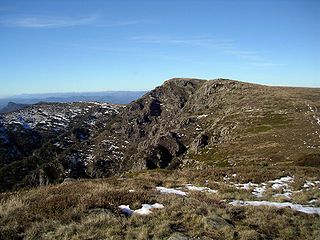
The Alpine National Park is a national park located in the Central Highlands and Alpine regions of Victoria, Australia. The 646,000-hectare (1,600,000-acre) national park is located northeast of Melbourne. It is the largest National Park in Victoria, and covers much of the higher areas of the Great Dividing Range in Victoria, including Victoria's highest point, Mount Bogong at 1,986 metres (6,516 ft) and the associated subalpine woodland and grassland of the Bogong High Plains. The park's north-eastern boundary is along the border with New South Wales, where it abuts the Kosciuszko National Park. On 7 November 2008 the Alpine National Park was added to the Australian National Heritage List as one of eleven areas constituting the Australian Alps National Parks and Reserves.

The Bavarian Forest National Park is a national park in the Eastern Bavarian Forest immediately on Germany's border with the Czech Republic. It was founded on 7 October 1970 as the first national park in Germany. Since its expansion on 1 August 1997 it has covered an area of 24,250 hectares. Together with the neighbouring Czech Bohemian Forest the Bavarian Forest forms the largest contiguous area of forest in Central Europe.

Transhumance is a type of pastoralism or nomadism, a seasonal movement of livestock between fixed summer and winter pastures. In montane regions, it implies movement between higher pastures in summer and lower valleys in winter. Herders have a permanent home, typically in valleys. Generally only the herds travel, with a certain number of people necessary to tend them, while the main population stays at the base. In contrast, horizontal transhumance is more susceptible to being disrupted by climatic, economic, or political change.

The Bavarian Alps is a collective name for several mountain ranges of the Northern Limestone Alps within the German state of Bavaria.

The clearing of woods and forests is the process by which vegetation, such as trees and bushes, together with their roots are permanently removed. The main aim of this process is to clear areas of forest, woodland or scrub in order to use the soil for another purpose, such as pasture land, arable farming, human settlement or the construction of roads or railways.

Arnschwang is a rural municipality in the district of Cham in Bavaria, Germany. The population was 2,004 as of the 2010 census. In recent years Arnschwang has focused on the production of environmentally friendly energy from biomass and water.

Alpine transhumance is transhumance as practiced in the Alps, that is, a seasonal droving of grazing livestock between the valleys in winter and the high mountain pastures in summer. Transhumance is a traditional practice that has shaped much of the landscape in the Alps, as without it, most areas below 2,000 m (6,600 ft) would be forests. While tourism and industry contribute today much to Alpine economy, seasonal migration to high pastures is still practiced in Bavaria, Austria, Slovenia, Italy, France and Switzerland, except in their most frequented tourist centers. In some places, cattle are taken care of by local farmer families who move to higher places. In others, this job is for herdsmen who are employees of the cooperative owning the pastures.

The Ammergau Alps are a mountain range in the Northern Limestone Alps in the states of Bavaria (Germany) and Tyrol (Austria). They cover an area of about 30 x 30 km and begin at the outer edge of the Alps. The highest summit is the Daniel which has a height of 2,340 metres (7,680 ft).
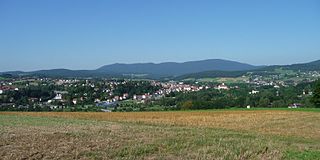
The Hohe Bogen is a roughly 8-kilometre-long mountain ridge in the Bavarian Forest.

Central Europe contains several life zones, depending on location and elevation.

A grinde is an almost treeless area of wet heathland found on the rounded bunter sandstone ridges of the Northern Black Forest in Germany. The grinden reached their greatest extent in the early 19th century when they ran from the Kniebis mountain near Freudenstadt in the south to the heights near Dobel in the north. Today they are restricted to the highest parts of the Northern Black Forest around the summits of the Hornisgrinde, Schliffkopf and Kniebis. They still cover an area of about 180 ha. Conservation measures and careful grazing by robust breeds of cattle, goats and sheep should enable the remaining grinden to be preserved for their great ecological value and as an important feature of the landscape. Most of them are under conservation orders.

The history of the forest in Central Europe is characterised by thousands of years of exploitation by people. Thus a distinction needs to be made between the botanical natural history of the forest in pre- and proto-historical times—which falls mainly into the fields of natural history and Paleobotany—and the onset of the period of sedentary settlement which began at the latest in the Neolithic era in Central Europe - and thus the use of the forest by people, which is covered by the disciplines of history, archaeology, cultural studies and ecology.
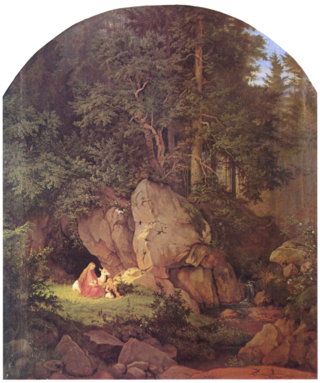
The German Forest was a phrase used both as a metaphor as well as to describe in exaggerated terms an idyllic landscape in German poems, fairy tales and legends of the early 19th-century Romantic period. Historical and cultural discourses declared it as the symbol of Germanic-German art and culture, or as in the case of Heinrich Heine or Madame de Staël, as a counter-image of French urbanity. It was also used with reference to historical or legendary events in German forests, such as Tacitus' description of the Battle of the Teutoburg Forest or even the nature mysticism of the stylized Germanic national myth, the Nibelungenlied as the history of its multi-faceted reception shows.
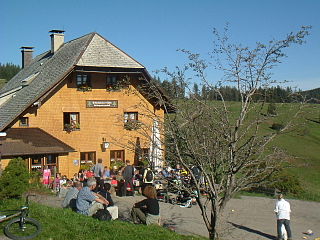
The Erlenbacher Hut is an inn and cattle hut (Almhütte) on the Erlenbach stream in the Black Forest in Germany.

The forest in Germany covers 11.4 million hectares, 32 percent of the total area of the country. In the German forests grow about 90 billion trees with a total wood stock of 3.7 billion cubic meters. The definition of the Federal Forest Act (BWaldG) for forest is: "any area planted with forest plants. Forest also includes clear-cut or shaded ground areas, forest roads, forest clearance and securing strips, forest meadows and clearings, forest meadows, grass clearing areas, wood storage areas and other areas associated with and serving the forest."
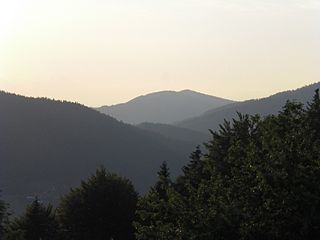
The Anterior Bavarian Forest, also variously called the Vorderer Forest, Vorderer Wald or Danube Hills, is part of the Bavarian Forest, a low mountain range in Germany.
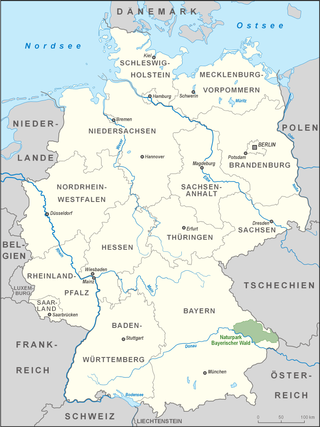
The Bavarian Forest Nature Park covers an area north of the Danube as far as the border ridge with the Czech Republic. Its sponsor organisation is the Naturpark Bayerischer Wald whose head office is in Zwiesel, Bavaria. It was established in 1967 and is thus the oldest nature park in Bavaria.

The Bavarian Forest Club, or BWV, is a German club that promotes culture, local history and folklore, nature and landscape conservation, and walking in the Bavarian Forest. It has its head office in Zwiesel and is registered in the register of clubs and societies in the district office at Deggendorf.

The Neuburg Forest is a largely forested hill ridge and natural region in Lower Bavaria in the county of Passau and the borough of Passau. It is named after the village of Neuburg am Inn.

The Höllbachgspreng is a wooded rock massif below the Großer Falkenstein mountain in the vicinity of Lindberg in the Bavarian Forest, Germany.